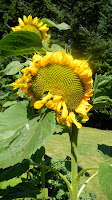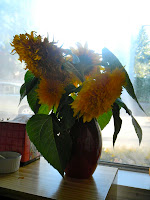"These words reveal the child's inner needs:
'Help me to do it alone.'"
Maria Montessori
Few things are more important to your children than independence. In the quote above, Dr. Montessori's words were translated from the Italian as, "Help me to do it alone." Closer to her intent might be the phrase we hear children say all the time, "I want to do it all by myself!" or "I did it!" - neither of which necessarily means alone. Here at Chickadee, we encourage children to expand their abilities to work independently, to develop their skills and self-sufficiency, and to succeed at new tasks. We think through the details and plan ahead. We start with the simplest needs - hanging up a coat, for instance - then expand into all of practical life. We set up the whole environment and curriculum to foster independence. Deep intention guides this commitment, because it is so good for children.
Cara is cutting potatoes for last week's roasted potato lunch dish. She has had many experiences with knives by now, starting with cutting soft bananas, on to cheese, finally to celery, carrots, and potatoes. This paring knife is sharp for a child (though any good cook would find it dull). She has been shown how to keep her non-dominant hand above the blade. She is absorbed in doing this independent, careful, and meaningful work. Not every child will be allowed to use the paring knife, by the way - he needs to do the preparatory work first and to demonstrate carefulness. And with knives, an unobtrusive but watchful teacher is always near at hand. Also near at hand are other children who are watching her work, impressed, and waiting their turn.
Independence builds confidence and a sense of empowerment in the child. It leads her forward joyfully to the next challenge, the next interest, the next learning, whatever it may be. Her absorbent mind is creating networked, neural synapses of success and strength, connecting left and right brain, and linking her will and her actions, in ways that neuroscience is only beginning to understand.
In Montessori we focus on supporting that independence because we know we are helping the child's brain and character to grow in optimal ways. Here are just three out of a multitude of examples....
In Montessori we focus on supporting that independence because we know we are helping the child's brain and character to grow in optimal ways. Here are just three out of a multitude of examples....
Megan is sewing a button onto fabric. She is using a sharp needle, learning to go up and down and not around the hoop, getting that button attached all by herself. Independence! What came home to her parents was just a bit of fabric with a button sewed into it. What could they not see but only guess at? Concentration, confidence, completion of a cycle of activity, pride - all were integral in such a small package of independent work. Each button matters!
Leo is filling the land forms with water, a work he did repeatedly this fall. He poured them ever so carefully, filling each one until it reached a perfect level of water tension, with not a drop spilled, not a drop overflowing. Behind this focused work were many experiences with basic pouring activities in all their variations, from pouring big white beans to pouring water into tiny cups. He can now pour independently and successfully in any context - he pours his own water for drinking, he pours his own milk at lunch, he serves juice to friends. He is skillful and confident. He is functionally independent.
Terra is our oldest this year, and the only one here with 3+ years of Montessori under her belt. So when she got paint on a favorite flowered dress last month, she dealt with it. She went to her extra clothes box and changed into another top. Then she got out the cloth-washing work, complete with a real scrub board. She mixed up some soapy water with grated soap, and then proceeded to scrub the paint out of that flowered dress. She scrubbed and scrubbed until the paint spots were all gone. Then she rinsed it thoroughly and hung it to dry.
The benefits of such independent work cannot be overemphasized. Sure, she could have thrown it in our washing machine, or more likely, she could have given it to her mom to throw in the washer. But instead, she took care of it herself, step by step, fully engaged, self-sufficient, and ultimately satisfied at a job well done.
Terra is our oldest this year, and the only one here with 3+ years of Montessori under her belt. So when she got paint on a favorite flowered dress last month, she dealt with it. She went to her extra clothes box and changed into another top. Then she got out the cloth-washing work, complete with a real scrub board. She mixed up some soapy water with grated soap, and then proceeded to scrub the paint out of that flowered dress. She scrubbed and scrubbed until the paint spots were all gone. Then she rinsed it thoroughly and hung it to dry.
The benefits of such independent work cannot be overemphasized. Sure, she could have thrown it in our washing machine, or more likely, she could have given it to her mom to throw in the washer. But instead, she took care of it herself, step by step, fully engaged, self-sufficient, and ultimately satisfied at a job well done.
Yes, the benefits of independence are far-reaching. And it's not just for a Montessori environment. An increasing level of independence is a core need for every child in every part of his life, from babyhood on - it's a part of every child's innate drive to "create himself." It was Wordsworth who said, "The child is the father of the man," but it could have been Montessori.
Your child is inevitably dependent on you, his parents, for all his big needs, for a very long time. But through these first, critical years of parenthood and childhood, you can set up your home life so that he or she grows in independence in the daily tasks of life, month by month, year by year. Yes, it takes lots of patience and a willingness to shift priorities, but it is totally worthwhile. "Help me to do it all by myself" - may these words become a guiding principle in your daily life with your children at home.
Independence! Here's a visual affirmation - Morgan, exuberantly expressing
"I did it!"







